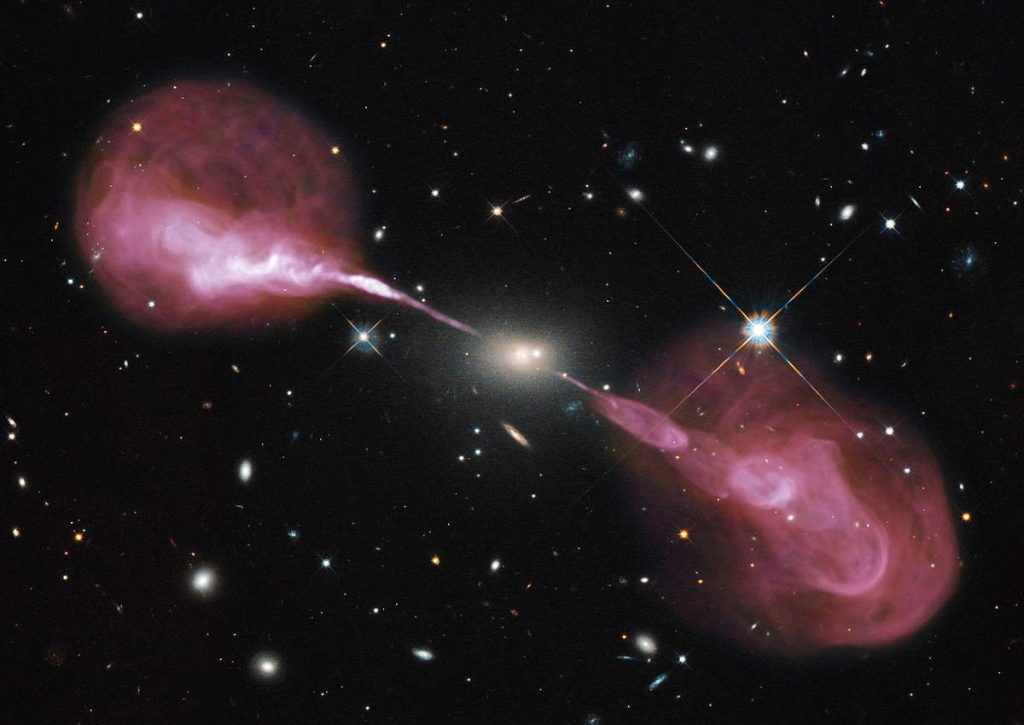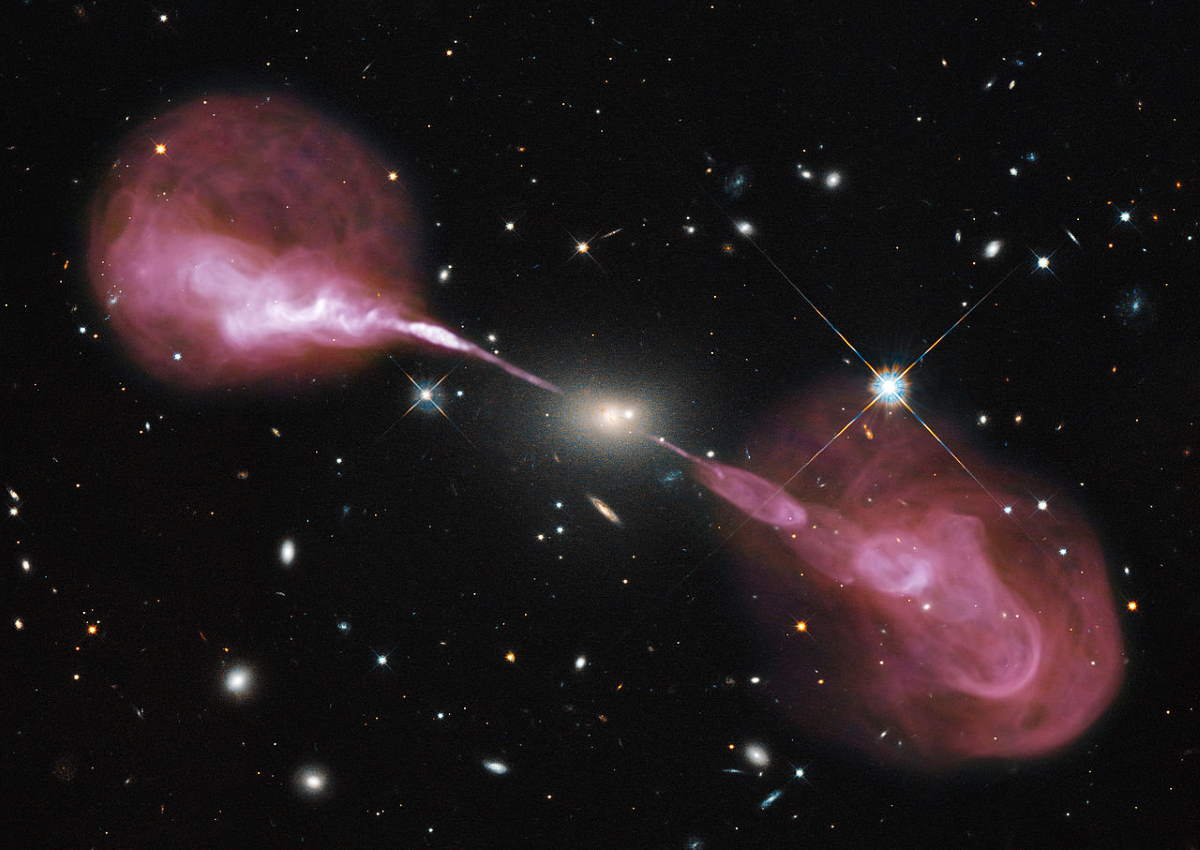Super-sized black holes appeared surprisingly early in the Universe and it seems every galaxy has one at its center. But how? And where are the intermediate-sized black holes (intermediate black holes)?
A deeper understanding of black holes could revolutionize our understanding of physics, but their mysterious nature makes them difficult to observe.
The weirdness exhibited by black holes boggles the mind. Formed when a star burns all its nuclear fuel and collapses under its own gravitation, black holes are such oddities that at one time, even Einstein didn’t think they were possible.
They are regions in space with such intense gravitation that not even light escapes their pull. Once magnificent shining stars burn out and shrink to a relatively tiny husk, all their mass is concentrated in a small space. Imagine our Sun with its diameter of roughly 1.4 million kilometers (870,000 miles) shrinking to a black hole the size of a small city just six kilometers (3.7 miles) across. This compactness gives black holes immense gravitational pull.
Not only do they trap light, but black holes can also shred any stars they encounter and even merge with each other. Events like this release bursts of energy that is detectable from billions of light-years away.
The Nobel Prize in Physics 2020 was shared by scientists Reinhard Genzel and Andrea Ghez who discovered an invisible object at the heart of the Milky Way that pulls stars towards it. This is a supermassive black hole or SMBH, and it has a mass that is millions of times that of our sun.
“At the heart of every massive galaxy, we think there is a supermassive black hole,” said astrophysicist Dr. Kenneth Duncan at the Royal Observatory in Edinburgh, UK. “We also think they play a really important role in how galaxies form, including the Milky Way.”

Related: First-ever image of a Black Hole
Supermassive black holes: galactic monsters
What is a supermassive black hole (SMBH)?
A supermassive black hole (SMBH or sometimes SBH) is the largest type of black hole. The mass of supermassive black holes can be on the order of millions to billions of times the mass of the Sun (M☉).
Supermassive black holes are literally the gravitating monsters of the Universe. “Black holes at the center of galaxies can be between a million and a few billion times the mass of our Sun,” said Professor Phillip Best, an astrophysicist at the University of Edinburgh.

They pull in gas and dust from their surroundings, even objects as large as stars. Just before this material falls in towards the black hole’s event horizon or point of no return, it moves quickly and heats up, emitting energy as energetic flashes. Powerful jets of material that emit radio waves may also spew out from this ingestion process.
These can be detected on Earth using radio telescopes such as Europe’s LOFAR, which has detectors in the UK, Ireland, France, the Netherlands, Germany, Sweden, Poland, and Latvia.
Duncan is tapping LOFAR observations to identify the massive black holes in a project called HIZRAD. ‘We can detect growing black holes further back in time,’ said Duncan, ‘with the goal being to find the very first and some of the most extreme black holes in the Universe.’
LOFAR can pinpoint even obscured black holes. Duncan has used artificial intelligence techniques to combine data from LOFAR and telescope surveys to identify objects of interest.
Better instruments
Better instruments will soon assist in this task. An upgrade to the William Herschel Telescope on La Palma, Spain, will allow it to observe thousands of galaxies at the same time. A spectroscope called WEAVE has the potential to detect supermassive black holes and to observe star and galaxy formation.
Radio signals indicate that supermassive black holes exist from as early as the first 5-10% of the Universe’s history. These are a billion solar masses, explained Best, who is the research supervisor.
The surprising part is that these giants existed in the early stages of the Universe. “You’ve got to get all this mass into a very small volume and do it extremely quickly, in terms of the Universe’s history,” said Best.
We know that following the Big Bang, the Universe began as an expanding cloud of primordial matter. Studies of cosmic background radiation indicate that eventually, clumps of matter came together to form stars. However, ‘The process where you form a blackhole as large as a billion solar masses is not fully understood,’ said Best.

Intermediate black holes
What is an intermediate black hole?
An intermediate black hole (or intermediate-mass black hole, IMBH) is a class of black holes with a mass in the range of 100-100,000 solar masses.
While studies of SMBHs are ongoing, Dr. Peter Jonker, an astronomer at Radboud University in Nijmegen, the Netherlands, is intrigued by the formation of black holes of intermediate scale.
He is studying the possible existence of intermediate black holes (IMBH) with the IMBH project. He notes that supermassive black holes have been observed since when the Universe was only 600 million years old. Scientists estimate the overall age of the universe to be around 13.8 billion years.
“The Universe started out like a homogenous soup of material, so how do you get clumps that weigh a billion times the mass of the sun in a very short time?” said Jonker.
While supermassive black holes might consume sun-like stars (called white dwarfs) in their entirety, intermediate black holes should be powerful enough to only shred them, emitting a revealing flash of energy.
“When a compact star, a white dwarf, is ripped apart, it can be ripped only by intermediate-mass black holes,” said Jonker. “Supermassive black holes eat them whole.” There are strong indications that intermediate black holes are out there, but there’s no proof yet.
He is searching for flashes of intense X-ray energy to indicate the presence of an intermediate black hole. The problem is when signals are detected, the intense flashes last just a few hours. This means the data arrives too late to be able to turn optical telescopes towards the source for observations.
“This happens once in 10,000 years per galaxy, so we haven’t seen one yet in our Milky Way,” said Jonker.
Jonker also seeks to observe the expected outcome of two black holes spinning and merging, then emitting a gravitational wave that bumps nearby stars. However, to discern these stars being jolted necessitates powerful space-based telescopes.
X-ray flashes
The Gaia satellite, launched in 2013, is providing some assistance, but a planned mission called Euclid will take higher resolution images and may help Jonker prove IMBHs exist. This satellite was due to be launched on a Russian rocket; it will now be launched with a slight delay on a European Ariane 6 rocket
Nonetheless, a small satellite – the Chinese Einstein Probe – is scheduled for launch in 2023 and will look out for flashes of X-ray energy that could signify intermediate black holes. Duncan in Edinburgh says that the search for intermediate black holes ties in with his own quest. “It can potentially help us solve the question of where the supermassive ones came from,” he said.
Right now, physicists rely on quantum theory and Einstein’s equations to describe how the Universe works. These cannot be the final say, however, because they do not fit well together.
“The theory of gravity breaks down near a black hole, and if we observe them closely enough,” said Jonker. “Our expectation is that we will find deviations from the theory and important advances in understanding how physics works.”
The research in this article was funded by the EU. If you liked this article, please consider sharing it on social media.
Sources
- This article was originally published in Horizon, The European Union Research & Innovation Magazine, with the title of “Finding the missing links of black hole astronomy”, by Anthony King.
- Supermassive black hole on Wikipedia
- Global food supply is in danger. Microalgae promise abundant healthy food and feed in any environment - September 27, 2022
- Turning waste into energy reduces the amount of waste entering landfills and helps to combat climate change - June 16, 2022
- Intermediate black holes: where are they? - May 8, 2022
